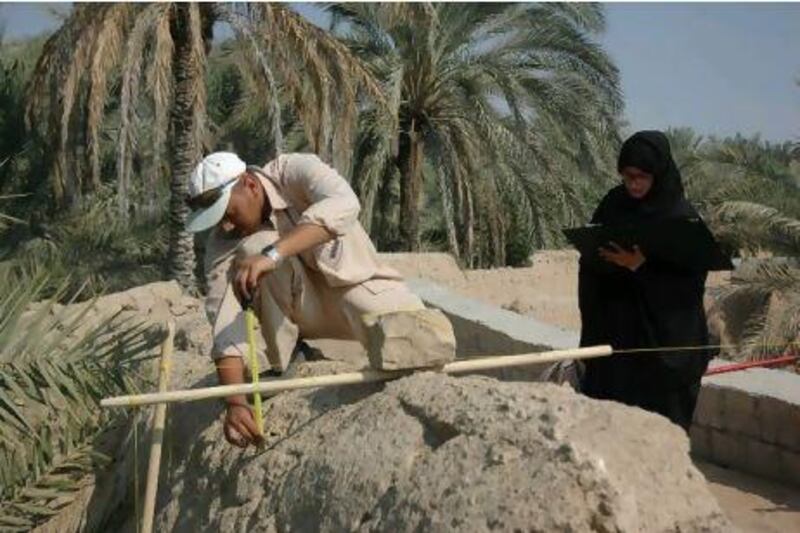AL AIN // Each morning for the past month a team of conservation experts has been hard at work in Al Ain's Jimi Oasis, preserving the legacy of the mud walls that - before buildings and air conditioning - provided shelter from the sandy winds and hot desert sun.
A pilot project run by the Abu Dhabi Authority for Culture and Heritage (Adach) is looking for ways to effectively restore and stabilise the walls that protect the oasis, and others like it.
Repairs to damaged sections of the walls began in January of this year after decades of decay.
"If we don't do it, we'll lose the original structures altogether," said Aqeel Aqeel, a historical building conservator with Adach who is supervising the project.
Before Al Ain was developed, shelter from the heat and access to water in the oasis made living there possible. In the past, farmers dug up ground to find fertile soil and control water drainage in the palm groves and gardens they cultivated. The clay they removed was used to craft the mud bricks and mortar that form the oasis' tall, sloping, protective walls.
But these walls have fallen into disrepair over time.
"It's not so much a reconstruction as it is the restoration and preservation of endangered walls. Some are nearing collapse," said Mr Aqeel, who is originally from Yemen. "We want to conserve it for future generations."
The project is expected to continue for at least another month, focused on a span of about 100 metres of mud wall. If the restoration succeeds, it will become a model for restoring similar structures in neighbouring oases. Of the seven oases in Al Ain, five have mud walls in need of urgent repair. Some of them are around 100 years old, and extend hundreds of kilometres throughout Al Ain.
The irrigation systems - underground channels known as "aflaj", which have kept the oasis fertile over centuries - have also damaged the inner base of the walls. Poor drainage has weakened the historic structures, as well.
As a result, the masonry is ebbing away, and some structures are collapsing. Previous attempts to restore the walls with concrete blocks have failed. Another approach was needed.
Assessing the need for restoration is based on urgency and the resources available to the Adach team.
"We started work to see how we can preserve the overall character of the farms," Mr Aqeel said. "We've already lost a great deal of the original material in the last 50 years. The walls may not seem as significant as well-known historic buildings, but they form the heritage of Al Ain and how its history and families have developed over time. If they're covered or protected in conventional ways, the character of the site and the images of the past would be lost."
The walls are restored using similar material crafted from mud, sand and straw from nearby areas.
"These few fragments of mud walls are the original features of the landscape and part of the historic legacy of the Emirates," said Benjamin Marcus, of the United States, who is a building conservator at Adach.
"The bricks are laid out to dry and made of mud mortar - comprised of soil, chopped straw, sand and water," Mr Marcus said. "The bricks are resistant to fracture and shrink in the sun. We don't use lime to coat the exterior. The straw acts as reinforcement and helps prevent the bricks from cracking, and is one of the best types of materials for insulating from the heat. They're manually created by expert craftsmen."
Mr Aqeel pointed out that the repair was not a permanent solution, as the replacement material will not last long. However, any intervention must be suitable for the overall environment, and will require more work in future, he said.
"The distinction between new and old material is still apparent, and a visitor can tell which parts are new and which are old," he added.
Another focus of the project is to document the significance of the walls. Two conservation experts supervise around 12 workers.
Interns from UAE University in Al Ain are also trained for future protection programmes and architectural restoration. Preservationists say they hope the students will use their skills after graduation.






